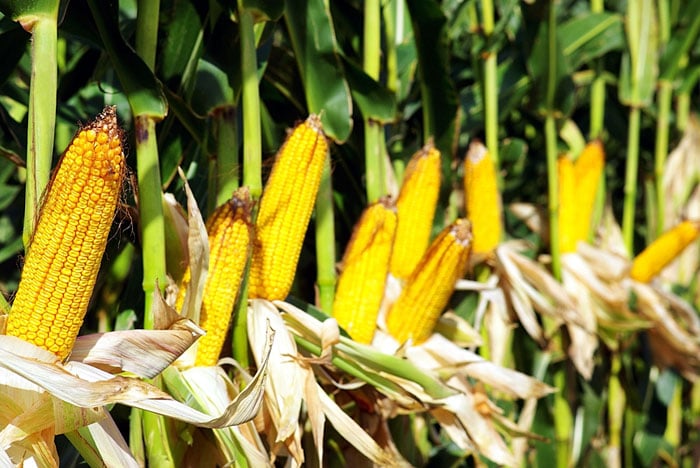
Written By: Sofia Layarda, MPH
Title: Master of Public Health
Alumni: University of California, Berkeley
Last Updated on:

Recently, close to one million California voters signed a petition to have a GMO-labeling initiative added to the November 2012 ballot. The goal is to have the state of California require labeling of any foods sold that have genetically engineered ingredients. However, if you don’t live in California and wish to avoid GM ingredients in the foods you buy, is there a way to do so that doesn’t require extensive detective work?

Table of Contents
There are four main crops mostly grown as GMO varieties in the U.S.: corn, canola, soy, and cotton, known as the “Big Four.” If you see these ingredients and their derivatives on an ingredient list, there is a very high likelihood they are of the GM type. Most of them are found in highly processed foods. The only exception is if the product is certified organic, because GMO ingredients are banned in organic products.
| GMO crops in the U.S. | Found as |
| Corn | corn meal, corn flour, corn starch, corn oil, corn syrup, corn sweetener, “modified food starch” |
| Canola (rapeseed) oil | cooking oil, oil in processed foods, e.g., chips |
| Soybean | soybean oil (in processed foods such as crackers, chips, cookies), soy lecithin, soy protein isolates or textured vegetable protein, soy flour, soy isoflavoneEditor’s Note: There is a big difference between consuming soy derivatives in processed foods and consuming whole soybeans in the form of tofu or soymilk; producers of whole soy products will specify their use of non-GMO soybeans. GMO soybeans are found in the production of soybean oil or other highly processed forms of soy (isolates, textured vegetable protein). |
| Cotton | vegetable oil blends, cottonseed oil for processed foods (cookies, crackers, chips) |
| Sugar beets | sweetener |
| Hawaiian papaya | fresh fruit (about half of all Hawaiian papayas sold in the U.S. are of the GMO variety). |
The U.S. government has also recently approved the use of GMO alfalfa, which is used mainly as feed for livestock.
A company recently filed for regulatory approval of its non-browning GMO apples, Arctic Apple, in both US and Canada. The company believes that non-browning apples are more appealing to consumers.
The best place to start is the Non-GMO Project, which was started in 2005 by two local neighborhood grocery stores, one in Berkeley, California and one in Toronto, Canada. The goal of this non-profit organization is to create “a standardized meaning of non-GMO for the North American food industry.” Since then the organization has expanded to include an independent third-party verification and labeling program for non-GMO food and products. Interested retailers and producers can submit their products for verification. Once a product has been “Non-GMO Project verified,” it can be labeled as such in the store, and it is added to their online database, which is also available as an app for iPhone and iPod Touch. You can also check out the Center for Food Safety’s Non-GMO Shoppers’ Guide (available as an app for iPhone and Android), but be aware that this guide is only based on companies’ statements, not independent genetic testing.
GMO ingredients are banned in products with the USDA “certified organic” label. However, one company may sell both organic and non-organic products with very similar packaging, so it still pays to be a label reader. The Cornucopia Institute produced a report on breakfast cereals that listed some companies using “bait-and-switch” tactics: The company started off using organic ingredients in all or the majority of their products, then later switched to non-organic, conventional ingredients without clearly acknowledging it. The three main examples identified in the cereal report are Annie’s Homegrown, Barbara’s Bakery, and Peace Cereal.
If you are not buying organic, look for non-GMO labels on products. Some companies will make the statement that the product has been made “without genetically modified ingredients,” while others will state on the label that specific ingredients are GMO-free, e.g., GMO-free soy lecithin. Be aware, though, that certified organic products are the only ones where GMO ingredients are banned.
Stick to buying mostly fresh produce and you will have a good chance of getting non-GMO products. The only genetically modified fruit in the U.S. market is Hawaiian papaya. Small amounts of zucchini, yellow crookneck squash, or sweet corn may be GMO, but this is where it pays off to talk to the local farmers and growers at the market to get a sense of whether they use GMO varieties in their crops. Become familiar with your local growers and dairy producers so you know where your foods comes from and how they are produced.
Despite the pervasiveness of GMO products, it is possible to find non-GMO foods when you start with the right resources. The bulk of GMO crops ends up as ingredients in highly processed foods, which is one more reason to avoid them.
Tell Us: Do you support GMO labeling?
Alumni: University of California, Berkeley – Sofia believes in bringing back fun and pleasure into everyday eating. She loves cooking, and is constantly experimenting with ingredients, creating recipes and trying them out on family and friends. Her latest interest lies in finding realistic and practical ways of environmentally-friendly food/eating habits.
grocery aisle, non-gmo, organic, sustainable eating
4 Easy Ways to Save Your End-of-Summer Harvest
Nutrition Faceoff: Hidden Valley Original Ranch Dressing vs. Fat-Free
Big corporations have ruined the food in this country. I have thrown out grapes, cantaloupe, plums, peaches this month. They may be from other countries, but, regardless they are unfit for human consumption. It’s a shame we can’t enjoy good healthy foods as we did forty years ago. Phony meat, ground coffee that has something else (possibly roots of some kind) to add to the weight for more profit. Greed is obvious in many foods. I mean some cheap additive that increases the weight.